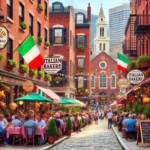Chicano art has long been an essential part of Los Angeles’ cultural fabric, representing the struggles, heritage, and identity of Mexican Americans. This artistic movement emerged as a form of resistance and empowerment during the civil rights era in the 1960s and 1970s. Today, it remains a vital expression of the Chicano community’s voice, combining social activism with artistic brilliance.
The Origins of Chicano Art
Chicano art arose during a time of social change, as Mexican Americans sought to assert their identity and combat inequality. This movement was closely tied to the Chicano Civil Rights Movement, or El Movimiento, which aimed to address issues such as labor rights, education reform, and cultural representation.
In the early stages, Chicano art was heavily influenced by Mexican muralism, a movement led by artists like Diego Rivera, David Alfaro Siqueiros, and José Clemente Orozco. These artists used large-scale murals to convey social messages, and Chicano artists in Los Angeles followed suit, painting public walls to reflect the struggles and aspirations of their communities.
Key Figures and Movements
Some of the most influential artists who shaped Chicano art in Los Angeles include:
- Carlos Almaraz: Known for his dynamic murals and vivid depictions of Los Angeles life.
- Judith F. Baca: Creator of “The Great Wall of Los Angeles,” one of the largest murals in the world, telling the history of ethnic communities in California.
- Willie Herrón: A pioneer in Chicano street art, Herrón brought attention to urban issues through his work.
These artists and many others have helped define Chicano art as not only a reflection of Mexican American culture but also as a vehicle for social change.
Themes and Styles in Chicano Art
Chicano art is distinguished by its rich use of symbolism and vivid, expressive colors. The art often incorporates elements from Mexican folklore, indigenous iconography, and Catholicism, blended with modern social commentary.
Key themes in Chicano art include:
- Identity and Heritage: Art that explores the complexity of being both Mexican and American, often portraying a fusion of both cultures.
- Social Justice: Many works address topics like immigration, inequality, and racism, calling for social change.
- Community and Family: Family and communal bonds are central motifs, highlighting the values that unite the Chicano community.
Iconic Chicano Art Spaces in Los Angeles
Los Angeles is home to some of the most important Chicano art spaces in the world. These venues and public art pieces continue to inspire new generations of artists and visitors alike:
- El Pueblo de Los Angeles Historical Monument: A key cultural site, this area celebrates the city’s Mexican roots and features murals and installations reflecting Chicano history.
- Self Help Graphics & Art: A community-based art organization that has been fostering Chicano and Latino artists for over 50 years.
- Chicano Park: Though technically in San Diego, its proximity to LA and significance to the Chicano movement make it a must-see. The park is home to over 70 vibrant murals reflecting the struggles and achievements of the Chicano community.
The Future of Chicano Art in Los Angeles
While Chicano art was born out of social struggle, it has evolved into a global artistic movement. Today, younger generations of Chicano and Latinx artists continue to push the boundaries, integrating new mediums such as digital art, performance, and installation, while maintaining the movement’s core values.
In Los Angeles, Chicano art remains more relevant than ever, addressing contemporary issues like gentrification, immigration policy, and identity in a rapidly changing world. Institutions such as the Los Angeles County Museum of Art (LACMA) and the Vincent Price Art Museum continue to exhibit Chicano artists, ensuring that their voices are heard by a broader audience.
Chicano art in Los Angeles is more than just a style or movement—it is a deeply rooted cultural expression of identity, community, and resistance. Its ability to adapt and evolve with the times ensures its continued relevance, both in the art world and in society at large. Whether you’re a local or a visitor, understanding Chicano art offers a unique lens through which to explore Los Angeles and the history of its vibrant communities.


